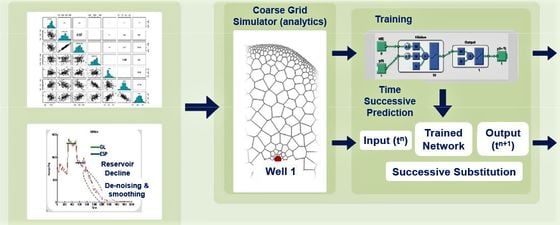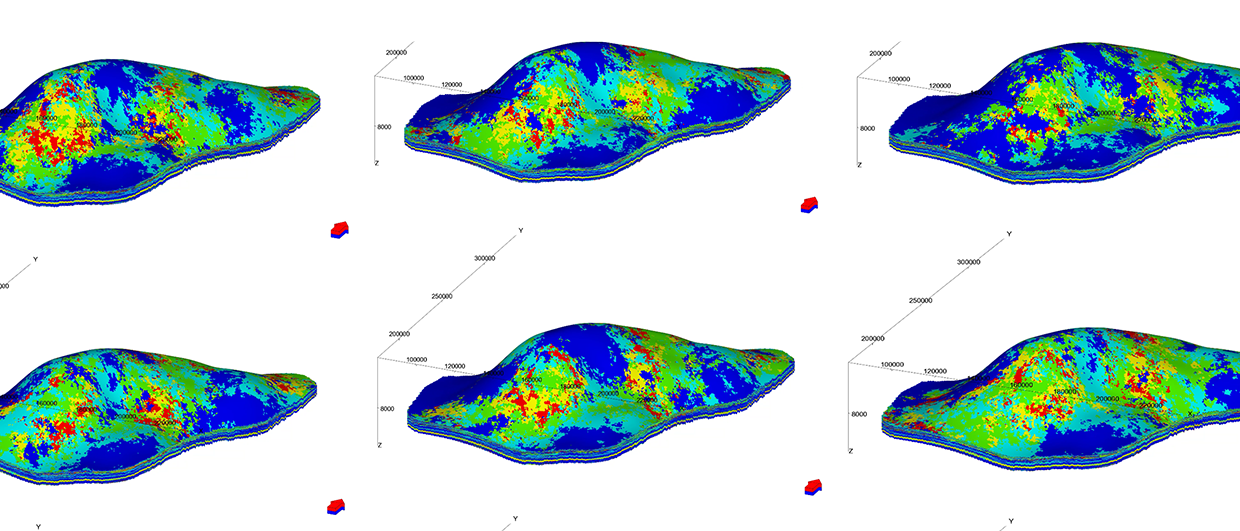Coupling deep learning methods with dynamic reservoir models can result in tremendous time saving and more reliable production forecasts in oil and gas production.
Reservoir models are vitally important in the oil and gas industry, for example for estimating remaining oil and gas reserves and providing production forecasts. Managing the operational and financial performance of an E&P asset is also heavily dependent upon having access to a current and reliable prediction of the dynamic reservoir behaviour. All this information is crucial for creating development and operational plans and providing an auditable cash flow to shareholders. It is therefore important to have an up-to-date and accurate reservoir model.
Graphic describing the high-level workflow. © Target Energy Solutions.
However, E&P asset operators have an issue, in that their optimum history matched dynamic reservoir models are becoming quickly out-of-date and ‘dormant’, due to the length of time it takes to update models. This means that frequent model updates are simply unaffordable. Engineers therefore often resort to using simpler approximation models to forecast production and remaining reserves, as these methods are faster and cheaper to use, although at the price of losing prediction accuracy.
This industry dilemma led engineers and scientists of the international technology and services company Target Energy Solutions to develop a new hybrid modelling method that couples conventional simulation with modern machine learning, thereby combining engineering knowledge of subsurface data with machine learning acquired through the stream of ‘big data’ coming from production.
A Revolutionary Breakthrough in Reservoir Prediction
This hybrid AI/physics-based system uses a conventional 3D, 3-phase numerical reservoir simulator coupled with a complex deep learning engine. The first step is to simply integrate an asset’s optimum dynamic reservoir model into Target’s platform MEERATM, and its AI-Simulation framework therein. This is done by re-assembling the components of the original conventional model, so it meshes into the machine learning framework. Various parameters are extracted from the original reservoir model, some of which, based on a comprehensive correlation analysis, are selected as key reservoir elements to be used for machine learning training and prediction. New production data is then incorporated, creating a rapidly self-updating live dynamic reservoir model that can be used as a reliable production forecasting and scenario-testing tool for operational planning and budgeting.
It takes just minutes to train the AI using historic production data, while successive prediction simulations take merely milliseconds.
The lack of time constraints means that it is possible to optimise a development strategy by running numerous scenarios in minutes, all based on the experience of the asset’s petroleum engineers. A reservoir model that is constantly being updated has the major advantage of allowing reliable maps of remaining hydrocarbons to be made, which can then be used to select optimum infill drilling locations. It also helps to provide stable and auditable cash-flow predictions to shareholders.
In comparison to purely data-driven processes, which mainly capture near-well behaviours, the system, known as MEERA Simulation, considers the whole reservoir’s interconnected behaviour and therefore all inter-well effects. This makes it ideal for studying the effects of processes like well injection, as well as for looking at how major structures like fractures and faults in the reservoir may impact the production rates.
Case Study 1: History Matching
The benefits of the utilisation of a system like this can be seen by looking at some completed projects. One example comes from a field that had started producing in 1985 and now has more than 80 production wells, with strong aquifer support. In this case study, production data was matched up to 2010 and the period 2010–2018 was used for blind test prediction. Each full field simulation run took 7 to 8 hours using commercial simulators, but when using MEERA Simulation, each history simulation took 12 minutes, while prediction simulations took 50–70 milliseconds, all on the same IT infrastructure.
Case study 1: Comparison of MEERA vs. conventional simulator in predicting oil production rates per well : (a) example in history match mode only, i.e. prior to 2010; (b) in both history match and prediction mode; and (c) well example in prediction mode only. © Target Energy Solutions.
These faster results meant the engineers could run multiple simulations in minutes to generate lots of different potential scenarios, thereby allowing for better optimisation of development strategies. In this case study, the field history proved to be matched better using this system than with the traditional commercial simulators, and in particular the blind test prediction was more accurate than the traditional simulation historical-matching of the same wells. The better the history matching quality, the better the understanding of the reservoir, which in turn leads to a better production optimisation and redevelopment decisions.
Case Study 2: Lack of Data
Lack of available data is often another issue that asset operators face. Confronted with this problem, a company that had been using a model built on a reservoir modelling tool suite widely used in the industry decided to test using MEERA Simulation to build their models. As a result of the machine learning built into the software, the lack of data was not such an issue and the client found that not only was it quicker to build models through this system, but that the history matching was more reliable than before. However, it must be emphasised that although machine learning can fill in data gaps, the more data that is available, the more accurate the outcome will be.
A key feature seen across both these case studies is that a tool like this, that includes machine learning, has the ability to integrate with other industry reservoir modelling applications, allowing it to read and write from these applications using data-exchange industry standards such as RESCUE. In addition, the tool also possesses a wide range of professional and easy-to-use data-handling utilities and visualisers, including 3D and 2D models, a chart visualiser and a histogram visualiser.
MEERA Simulation: Evergreen Reservoir Model Predictions
Field development decision making needs reliable predictive calculations, so a hybrid approach to reservoir modelling, using a fully coupled simulator with an AI/machine learning engine, is an obvious way forward. The result benefits from the history matching capabilities of artificial intelligence combined with the proven forecasting capabilities of a conventional reservoir simulator, while preserving local and global physical consistency.
With their evergreen model predictions and machine learning abilities, tools like MEERA Simulation have the potential to revolutionise the way that reservoir models are built and producing fields are developed.
Further Reading on the Use of AI in Hydrocarbon E&P
Artificial Intelligence and Petroleum System Risk Assessment
Mathieu Ducros and Félix Gonçalves; Kognitus
Using artificial intelligence to assess hydrocarbon charge risks.
This article appeared in Vol. 17, No. 1 – 2020
Advancing Geophysical Interpretation in Oil and Gas Exploration
Gehrig Schultz, Chris Tucker and Kirsty Simpson; EPI
Geophysics must change – but it must also remain meaningful.
This article appeared in Vol. 16, No. 3 – 2019
Artificial Intelligence and Seismic Interpretation
James Lowell, Peter Szafian and Nicola Tessen; GeoTeric
The key to all seismic interpretation is the interpreter’s experience and knowledge, so why should artificial intelligence change that? The reality is, it shouldn’t.
This article appeared in Vol. 16, No. 2 – 2019
One Step Closer to Fully Automated Fault Extraction in 3D Seismic Data
Sven Philit, Fabien Pauget, Sebastien Lacaze; Eliis, Caroline Guion; Eliis Inc.
To boldly go where no interpreter has gone before, getting one step closer to achieving the fully automated detection of faults in 3D seismic data.
This article appeared in Vol. 16, No. 1 – 2019
Using AI to Estimate Hydrocarbon Prospect Size
Halfdan Carstens
With the recent advances in technology and adoption of machine learning in geosciences, is it time for AI to take a hand in estimating hydrocarbon prospect sizes?
This article appeared in Vol. 15, No. 6 – 2018
Artificial Intelligence in Oil & Gas Production
Bjørn-Erik Dale & Vidar Uglane; Solution Seeker AS
Solution Seeker, a Norwegian tech start-up and spin-off from the Norwegian University of Science and Technology, is developing the world’s first artificial intelligence for real-time production optimisation.
This article appeared in Vol. 15, No. 3 – 2018





